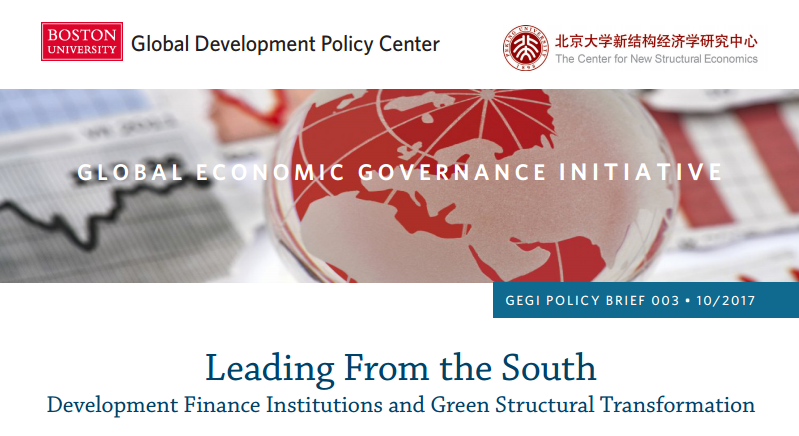英文首页﹀
Leading From the South: Development Finance Institutions and Green Structural Transformation
2017-10-16
Content introduction:

To help fill the knowledge gap on Southern-led development banking, the Center for New Structural Economics at Peking University and the Global Economic Governance initiative (GEGI) at Boston University’s Global Development Policy Center (GDP Center) convened a June 2017 Beijing workshop of senior development bank officials from 6 Southern-led Development Finance Institutions (SDFIs) to assess the extent to which development banks are becoming catalysts for achieving a climate friendly and more socially inclusive economy and to learn from each other’s experiences.
Our workshop drew from a regionally representative set of SDFIs from across the world-- the Islamic Development Bank headquartered in Saudi Arabia, the New Development Bank (NDB) currently governed by BRICS countries and the Asian Infrastructure Investment Bank (AIIB), started by China but now consisting of 80 countries including major advanced economies except the United States and Japan. As for national development banks, we have selected China Development Bank (CDB) from Asia, Development Bank of Southern Africa (DBSA) from Africa, and Nacional Financiera (NAFINSA) from Latin America.
The joint policy brief argues that the private marketplace is not equipped to make such investments on its own, and thus Development Banks arguably have the most important role in triggering a low-carbon transformation of the world economy. Furthermore, it holds that while Southern-led developmental financial institutions are beginning to play leadership roles in green energy finance, they also face six major challenges: (a) lack of clear policy definitions, goals, and directives for green energy; (b) limited capacity for green energy project preparation; (c) barriers to blending instruments to make green energy financially viable; (d) insufficient capabilities to leverage international and local financing; (e) policy uncertainty in the field of green energy deters long-term committed capital; and (f) constraints from international rules and institutions
To overcome the above challenges, three preliminary recommendations can be put forth: (a) link national development strategies with Sustainable Development Goals (SDGs) to ensure clearly-defined targets for achieving long-term goals for green energy finance; (b) establish platforms for fostering mutual learning among DFIs on how to solve sector specific binding constraints in green energy investment and how to tailor financing strategies in line with different development stages; (c) collectively address constraints posed by credit rating agencies and international banking rules on SDFI capacities to mobilize green energy finance.
To See Full Report : Leading From the South Development Finance Institutions and Green Structural Transformation

